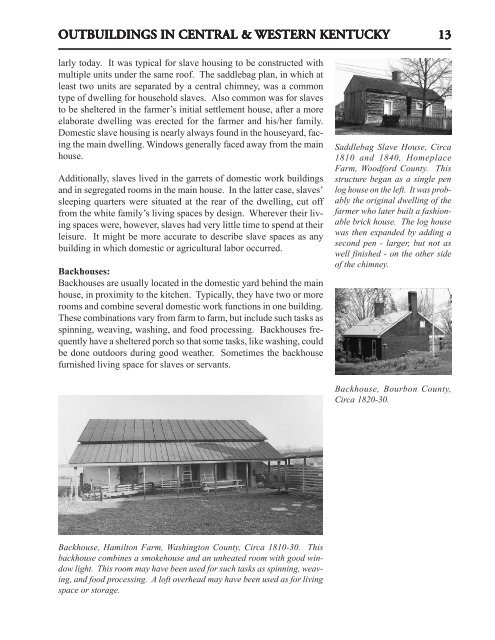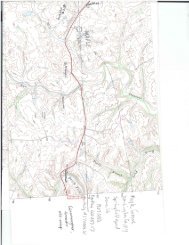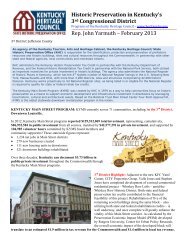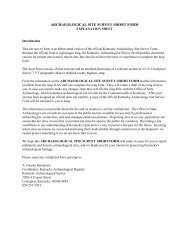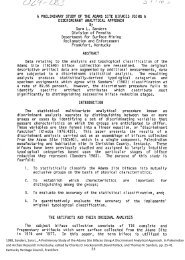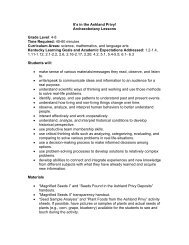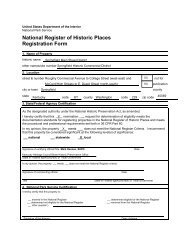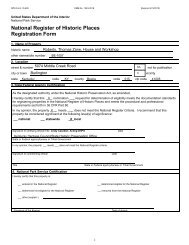Agricultural and Domestic Outbuildings in Central and Western
Agricultural and Domestic Outbuildings in Central and Western
Agricultural and Domestic Outbuildings in Central and Western
Create successful ePaper yourself
Turn your PDF publications into a flip-book with our unique Google optimized e-Paper software.
OUTB OUTB OUTBUILDINGS OUTB OUTB UILDINGS IN IN CENTRAL CENTRAL & & WESTERN WESTERN KENTUCKY KENTUCKY 13<br />
13<br />
larly today. It was typical for slave hous<strong>in</strong>g to be constructed with<br />
multiple units under the same roof. The saddlebag plan, <strong>in</strong> which at<br />
least two units are separated by a central chimney, was a common<br />
type of dwell<strong>in</strong>g for household slaves. Also common was for slaves<br />
to be sheltered <strong>in</strong> the farmer’s <strong>in</strong>itial settlement house, after a more<br />
elaborate dwell<strong>in</strong>g was erected for the farmer <strong>and</strong> his/her family.<br />
<strong>Domestic</strong> slave hous<strong>in</strong>g is nearly always found <strong>in</strong> the houseyard, fac<strong>in</strong>g<br />
the ma<strong>in</strong> dwell<strong>in</strong>g. W<strong>in</strong>dows generally faced away from the ma<strong>in</strong><br />
house.<br />
Additionally, slaves lived <strong>in</strong> the garrets of domestic work build<strong>in</strong>gs<br />
<strong>and</strong> <strong>in</strong> segregated rooms <strong>in</strong> the ma<strong>in</strong> house. In the latter case, slaves’<br />
sleep<strong>in</strong>g quarters were situated at the rear of the dwell<strong>in</strong>g, cut off<br />
from the white family’s liv<strong>in</strong>g spaces by design. Wherever their liv<strong>in</strong>g<br />
spaces were, however, slaves had very little time to spend at their<br />
leisure. It might be more accurate to describe slave spaces as any<br />
build<strong>in</strong>g <strong>in</strong> which domestic or agricultural labor occurred.<br />
Backhouses:<br />
Backhouses are usually located <strong>in</strong> the domestic yard beh<strong>in</strong>d the ma<strong>in</strong><br />
house, <strong>in</strong> proximity to the kitchen. Typically, they have two or more<br />
rooms <strong>and</strong> comb<strong>in</strong>e several domestic work functions <strong>in</strong> one build<strong>in</strong>g.<br />
These comb<strong>in</strong>ations vary from farm to farm, but <strong>in</strong>clude such tasks as<br />
sp<strong>in</strong>n<strong>in</strong>g, weav<strong>in</strong>g, wash<strong>in</strong>g, <strong>and</strong> food process<strong>in</strong>g. Backhouses frequently<br />
have a sheltered porch so that some tasks, like wash<strong>in</strong>g, could<br />
be done outdoors dur<strong>in</strong>g good weather. Sometimes the backhouse<br />
furnished liv<strong>in</strong>g space for slaves or servants.<br />
Backhouse, Hamilton Farm, Wash<strong>in</strong>gton County, Circa 1810-30. This<br />
backhouse comb<strong>in</strong>es a smokehouse <strong>and</strong> an unheated room with good w<strong>in</strong>dow<br />
light. This room may have been used for such tasks as sp<strong>in</strong>n<strong>in</strong>g, weav<strong>in</strong>g,<br />
<strong>and</strong> food process<strong>in</strong>g. A loft overhead may have been used as for liv<strong>in</strong>g<br />
space or storage.<br />
Saddlebag Slave House, Circa<br />
1810 <strong>and</strong> 1840, Homeplace<br />
Farm, Woodford County. This<br />
structure began as a s<strong>in</strong>gle pen<br />
log house on the left. It was probably<br />
the orig<strong>in</strong>al dwell<strong>in</strong>g of the<br />
farmer who later built a fashionable<br />
brick house. The log house<br />
was then exp<strong>and</strong>ed by add<strong>in</strong>g a<br />
second pen - larger, but not as<br />
well f<strong>in</strong>ished - on the other side<br />
of the chimney.<br />
Backhouse, Bourbon County,<br />
Circa 1820-30.


